Missing But Not Forgotten
by
Edward J. "Ed" Steenberg, Saint Paul Police Historical Society
The next time you go up to the Chief's office, stop and take a look at the photographs of our past Chiefs of Police on the wall just outside the office suite. Look close and you will see that some of the photos are missing. But, if you look real close, you will notice that there is a new (old) picture, that of John Jones who was our Chief of Police in 1866-1867.
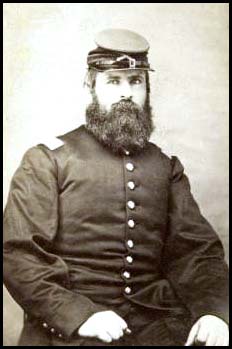
Captain John Jones (1863-1866)
Third Minnesota Light Artillery Battery
Some months back, a member of one of our Citizen Police Academy sessions noticed the missing photographs. A military history buff, he thought that he recognized one of the names, that of Captain John Jones, a career soldier (1846-1866) who later resided in our fair city. The rest of the research was conducted by historical society members.
John Jones1 was born in Middlesex, England on December 5, 1824. He came to America at about the time the Mexican War commenced. He enlisted in the United States Army on August 20, 1845 in Company K, First Regiment of Artillery, and shortly thereafter was promoted to the rank of corporal. Jones fought in the principal battles of the war, and for distinguished service in the Battle of Monterrey2 on September 23, 1846, he later received a "Reward of Merit" signed by President Franklin Pierce3 and Secretary of War Jefferson Davis4. He was severely wounded on August 20, 1847 in the Battle of Churubusco5 when shot in the neck with a musket ball. Allowed to continue his career in the army, he advanced to sergeant on December 8, 1847, and reenlisted at Fort Hamilton (New York) where he acted as quartermaster sergeant; on February 8, 1856 he was appointed ordnance sergeant.
Sergeant Jones came to Minnesota Territory early in 1856, assigned to the horse artillery battery of Major Thomas W. Sherman6. He was initially stationed at Fort Snelling7 (MN Territory), but soon went with the battery to Fort Ridgely8 (MN Territory), arriving there in May, 1856. Jones commanded the artillery at the fort during the siege by Little Crow and the Dakota Indians starting on August 20, 1862, and was largely credited with the survival of the post9. It should be noted that Jones' pregnant wife and children barely escaped capture from their outer wooden quarters the first day of the siege. She gave birth stillborn the next day. The U.S. Census records have the family still living in a log cabin near the stone barracks that housed the soldiers at Fort Ridgely in 1860.
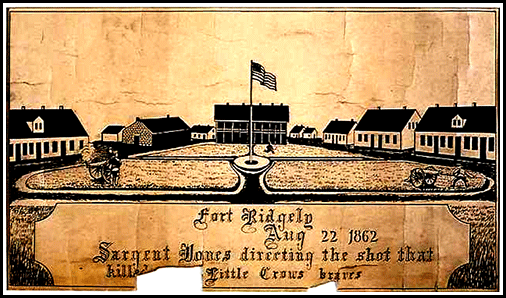
Sergeant John Jones, U.S. Army Ordnance, at Fort Ridgely
In the early part of 1863, Jones received an honorable discharge from the regular army to become captain in the Third Light Artillery Battery of the Minnesota Volunteers, commanding the unit from February 25, 1863 to February 27, 1866. He participated in General Henry Hastings Sibley's10 1863 expedition into Dakota Territory in pursuit of the Dakota Indians, participating in the Battle of Tah Kah A Kuty (Killdeer Mountain) on July 28, 1864 and saw action at Two Hills, the Badlands, and at the Little Missouri River, August 8 through 9, the same year. Jones received an honorable discharge from this command on February 27, 1866.
Jones was appointed St. Paul chief of police on July 8, 1866, and after one term in that capacity retired to private life. He practiced veterinary medicine from 1871 until his death at his home in St. Paul on May 4, 1886. At time of death, Dr. John Jones lived at 21 West Tenth Street in St. Paul. Survived by his wife Maria and at least three of his children, he is buried in Oakland Cemetery (Plot: 44,178), St. Paul.
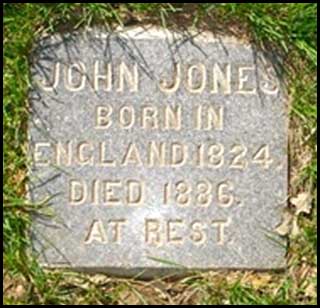
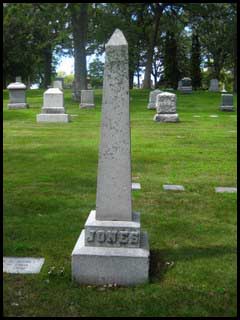
Federal census records indicate that Chief John Jones' family included wife Maria "Lab" Jones (1834-1899), daughters Ellen Lucy "Nellie" (1860-1932) and Martha (1872-1905), as well as sons George William (1801-??), and John Henry Jones (1868-1938). We have yet to locate any living relatives or a photo of Chief Jones in police uniform.
Parts of the above biographical information were taken from an anonymous chronologic manuscript and from an obituary notice from the old St. Paul Daily Globe, both found in a Minnesota History Center collection [MHS Manuscripts Notebooks: P1513]. Additional information was obtained by independent research.
Part of the MHS John Jones collection includes the original Certificate of Merit signed by President Franklin Pierce on September 19, 1853, and the military orders signed on December 6, 1862 by President Abraham Lincoln calling for the disciplinary action to be taken against the Dakota Indians after the siege on Fort Ridgely in the MN Territory11. Also in same collection is the original Certificate of Appointment as St. Paul Chief of Police12.
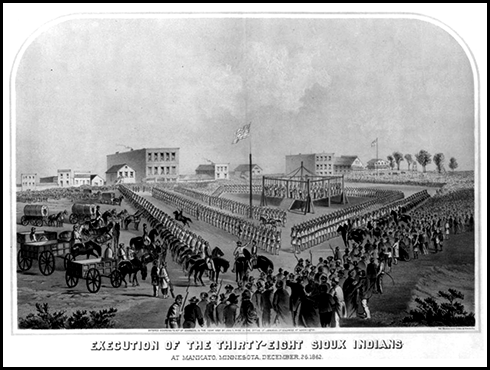
Chief John Jones' official departmental photograph may have been missing, but he was definitely not forgotten. The new (old) photograph hanging on the wall just outside the chief's office suite is of Captain John Jones in military uniform.
1 John Jones (1824-1886) was appointed St. Paul chief of police on July 8, 1866, and after one term in that capacity retired to private life. He practiced veterinary medicine from 1871 until his death in St. Paul on May 4, 1886.
2 In the Battle of Monterrey (September 21-24, 1846) during the Mexican-American War, General Pedro de Ampudia and the Mexican Army of the North was defeated by the Army of Occupation, a force of United States Regulars, Volunteers and Texas Ranges under the command of General Zachary Taylor.
3 Franklin Pierce (1804-1869) was the 14th President of the United States (1853-1857) and also served in the U.S. House of Representatives and the Senate. Pierce took part in the Mexican-American War and became a brigadier-general in the Army prior to his presidential election.
4 A graduate of the U.S. Military Academy at West Point Jefferson Finis Davis (1808-1889) was a U.S. soldier and statesman, and was the President of the Confederate States of America (1861-1865) during the American Civil War. Davis took part in the Mexican-American War and became a colonel of a volunteer regiment prior being appointed as the U.S. Secretary of War (1853-1857) under President Franklin Pierce.
5 The Battle of Churubusco took place on August 20, 1847, while Santa Anna's army was in retreat from the Battle of Contreras (Padierna), during the Mexican-American War. After defeating the Mexican army at Churubusco, the U.S. Army was only five miles (8 km) away from Mexico City.
6 Major Thomas W. Sherman (1813-1879) was on frontier duty at Fort Snelling from 1853 to 1857, and in other assignments in the Minnesota/Dakota Territory until the start of the U.S. Civil War. He received a volunteer commission as brigadier general on May 17, 1861. In recognition of his heroism and services, Sherman was brevetted to the rank of major-general at the end of the war.
7 Fort Snelling, originally known as Fort Saint Anthony, was a military fortification (1819-1946) located at the confluence of the Minnesota River and the Mississippi River in Hennepin County.
8 Fort Ridgely was a U.S. Army outpost (1853-1867) near the Dakota reservation in southwestern Minnesota (located near Fairfax). It played an important role in the Dakota War of 1862.
9 Sergeant John Jones played perhaps the most pivotal role in the defense of Fort Ridgely. Because he was trained in the use of artillery, he also trained the members of Minnesota's 5th Regiment, which proved to be invaluable in defending this difficult-to-defend fort. Using unseasoned troops, many of whom were raw recruits, Jones was able to repeal the Indian attacks.
10 Henry Hastings Sibley (1811-1891) was the first Governor of the U.S. State of Minnesota and a U.S. Representative of the Minnesota Territory and the Wisconsin Territory. In 1862, after the American Civil War began, Sibley was appointed colonel of the state militia and charged with the defense of the western frontier. He was promoted to brigadier-general for his actions during the Dakota Uprising, and later brevetted as major-general.
11 On December 6, 1862, President Abraham Lincoln notified General Henry Hastings Sibley that he should "cause to be executed" thirty-nine of the 303 convicted Santee (Eastern Dakota) Sioux. The execution by mass hanging took place in Mankato, Minnesota, on the 26th of December. At the last minute one Indian was given a reprieve.
12 John Jones and family papers, 1823-1937 (0.4 cu ft box): Primarily letters, certificates, and memorabilia documenting Jones' activities as a frontier soldier in Minnesota and Dakota Territory (1856-1866), especially his command of the artillery at Fort Ridgely during the 1862 Dakota Conflict and his subsequent participation in the punitive Sibley expedition into Dakota Territory (1863). There are also letters to Jones' daughter Nellie, family letters from England (1823, 1847), and miscellany documenting Jones' service in the Mexican War (1846-1847) and as St. Paul (Minnesota) chief of police (1866).
